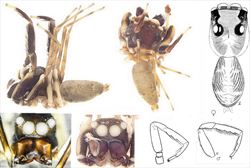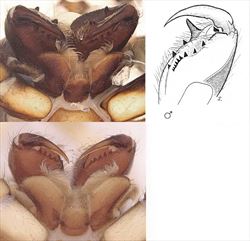
Examples of live Jacksonoides
Illustrators (and ©) I.R. Macaulay (TR, R. Whyte

Aspects of the general morphology of Jacksonoides
Illustrators (and ©) B.J. Richardson (CSIRO) & M. Żabka (diag.) (QMB)

Aspects of the chelicera of Jacksonoides
Illustrators (and ©) B.J. Richardson (CSIRO) & M. Żabka (diag.) (QMB)

Palp and epigyne morphology of Jacksonoides kochi
Illustrators (and ©) B.J. Richardson (CSIRO), M. Żabka (diag.) (QMB)
Jacksonoides Wanless, 1988
Taxonomy
Jacksonoides has seven Australian species: Jacksonoides distinctus, J. eileenae, J. kochi, J. nubilis, J. queenslandicus, J. simplexipalpis and J. subtilis. The genus is part of an Australasian clade (Maddison et al 2008) including Adoxotoma, Arasia, Astia, Astilodes, Helpis, Megaloastia, Parahelpis, Sondra and Tauala. Genera from Indonesia (Katya) and the Philippines (Orthrus) may also be part of this group (Maddison 2015). Further information on the genus and described species can be found in Richardson and Żabka (2017) and Whyte and Anderson (2017).
Description
Jacksonoides spp. are small to medium-sized spiders, body length 3 to 8 mm, with a high, rounded carapace, widest behind the lateral eyes. The dorsal surface of the carapace is depressed between the posterior lateral eyes which are on distinct tubercules. The rear surface of the carapace is steep. Chelicerae are robust and rounded, often with a sculptured front surface. In some species there is a small tooth-like projection on the front surface used in mating. There are 8-11 retromarginal (plurident) teeth. The first pair of legs is long, with fringes on the tibiae and metatarsi, with long and strong spines on the tibiae and metatarsi of legs one and two.
The male’s palp has a long, slender embolus arising from the prolateral or distal margin of the rounded tegulum. The multi-lobed retro-lateral tibial apophysis can be simple or subdivided to give a butterfly-like or other appearance.
The female’s copulatory openings are anterior to the roundish spermathecae. Long simple insemination ducts travel to join the lateral edges of the spermathecae. There is an atrium between the copulatory openings and the spermathecae.
Biology
Jacksonoides spp. are very commonly caught in pitfall traps and can also be collected from foliage in the rainforests east of the Great Dividing Range of Australia north of Sydney. This genus has been used for extensive studies of spider behaviour by R.R. Jackson and co-workers and P.W. Taylor and co-workers.
Distribution
Jacksonoides is found along the east coast of Australia from Sydney north to Cape York.
References
Davies, V.T. & Żabka, M. 1989. Illustrated keys to the genera of jumping spiders (Araneae: Salticidae) in Australia. Memoirs of the Queensland Museum 27, 189-266.
Cross, F. R. &. Jackson, R.R. 2009. How cross-modality effects during intraspecific interactions of jumping spiders differ depending on whether a female-choice or mutual-choice system is adopted. Behavioural Processes 80, 162-168.
Gardzińska, J. & Żabka, M. 2010. A new genus and five new species of Astieae (Araneae: Salticidae) from Australia, with remarks on distribution. Zootaxa 2526: 37-53.
Prenter, J., Perez-Staples, D. & Taylor, P.W. 2010. The effects of morphology and substrate diameter on climbing and locomotor performance in male spiders. Functional Ecology 24, 400-408.
Maddison, W.P. 2015. A phylogenetic classification of jumping spiders (Araneae: Salticidae). Journal of Arachnology 43, 231-292.
Maddison, W.P., Bodner, M.R. & Needham, K.M. 2008. Salticid spider phylogeny revisited, with the discovery of a large Australian clade (Araneae: Salticidae). Zootaxa 1893, 49-64.
Richardson, B.J. & Żabka , M. 2016. Salticidae. Arachnida: Araneomorphae. Canberra, Australian Faunal Directory. Australian Biological Resources Study, at https://biodiversity.org.au/afd/taxa/SALTICIDAE.
Wanless, F.R. 1988. A revision of the spider group Astieae in the Australian Region. New Zealand Journal of Zoology 15, 81-172.
Whyte, R. & Anderson, G. 2017. A Field Guide to Spiders of Australia. CSIRO Publishing: Clayton.
* The information sheet should be interpreted in the context of the associated diagrams and photographs. Diagrams explaining anatomical terms can be found in the ‘Salticidae’ pictures at the beginning of the list of genera.